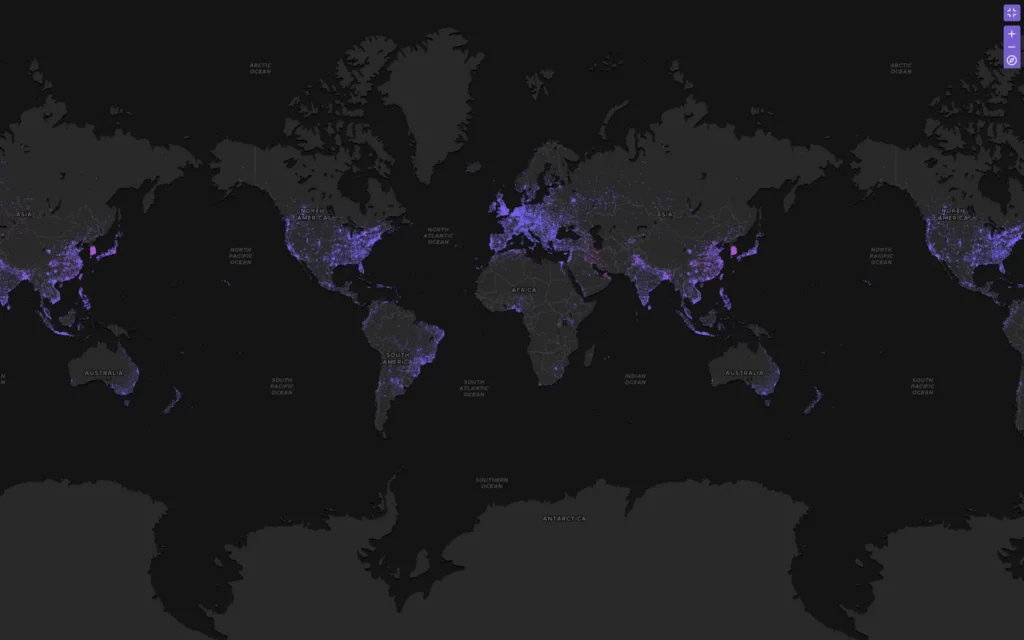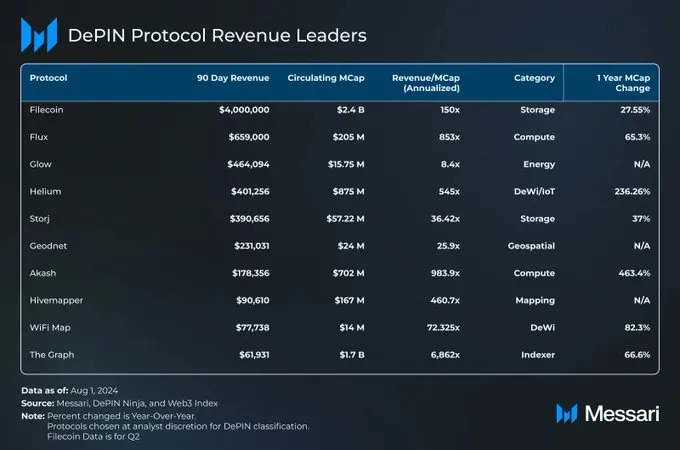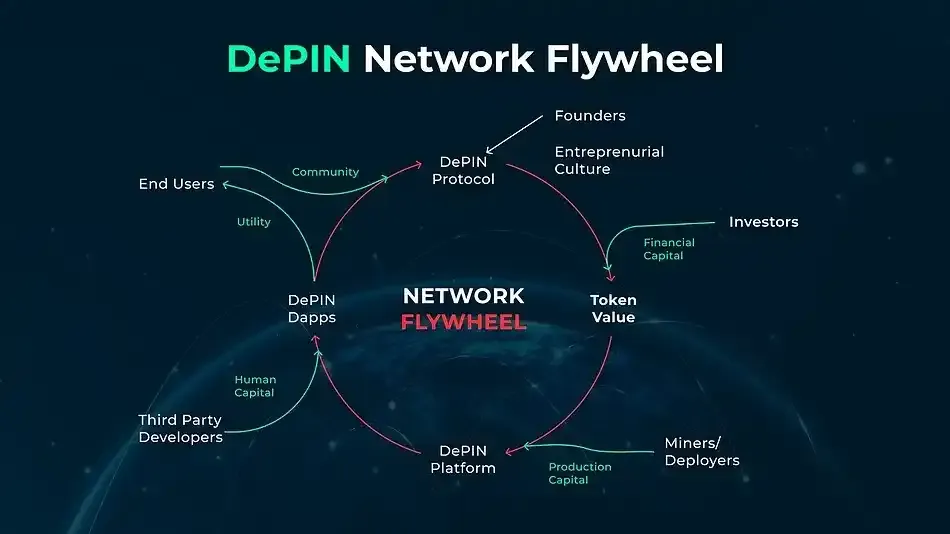DePIN Overview: Exploring the Current Landscape and Eight Emerging Projects
We have witnessed the rise of DeFi Summer, the NFT craze, and the Metaverse frenzy. Is the next big wave shifting towards DePIN?
During 2020-2021, the market cap of DeFi surged nearly 100 times, from $1.75 billion to $172.2 billion. If DeFi experiences a 10x growth in the current bull market, and DePIN reaches 50% of DeFi’s market cap, DePIN could surpass $500 billion in total market cap, offering at least 20 times growth potential. Messari estimates that by 2028, DePIN’s market cap could reach $3.5 trillion, indicating a potential 120x growth opportunity.
Next, we will review eight hot DePIN projects that have launched since 2024, some of which have yet to issue tokens or have just completed funding, shedding light on the future trends in this emerging sector.
DePIN Current Status
DePIN stands for Decentralized Physical Infrastructure Networks. It incentivizes users to share personal resources to build infrastructure networks, covering areas such as storage, bandwidth, cloud computing, and energy.
In simple terms, DePIN decentralizes infrastructure traditionally provided by centralized companies, distributing it among global users in a crowdsourced manner.

The DePIN ecosystem can be divided into six major categories: computing, wireless, energy, artificial intelligence, services, and sensors. Within these core areas, new narratives are emerging, such as the rise of decentralized gaming infrastructure (DeGIN) in computing networks, the application of AI data layers in bandwidth networks, breakthroughs in robotics within mobile networks, and the manufacturing industry’s demand for mobile networks.
This year has seen a significant recovery in venture capital funding for crypto projects. According to Rootdata, as of August 2024, global investments have reached $6.7 billion. Recently, the rise of DePIN networks has demonstrated a market fit similar to the early stages of the “sharing economy.” These projects span multiple areas of DePIN, each showcasing unique application scenarios.
Notable investment highlights include io.net, a distributed GPU project based on Solana, which raised $20 million in its Series A round, with a token valuation of $1 billion. Another noteworthy project is Aethir, a decentralized GPU computing node provider, which raised $65 million within the first hour of its node sale. These achievements mark the rapid maturation of the DePIN sector, attracting massive investments and widespread attention.

According to Messari, the total market cap of DePIN projects has surpassed $20 billion. Filecoin leads with a market cap of $2.4 billion, followed by Render Network at $2.2 billion, and Opentensor at $2.1 billion. Among the top eight DePIN protocols by market cap, seven belong to DRN (Decentralized Resource Networks), with a combined market cap of $12.2 billion.

Helium is the only Physical Resource Network (PRN) in the top eight, with a market cap of $870 million, ranking seventh. These figures highlight the rapid development of the DePIN sector and its diverse investment opportunities.
Currently, DePIN has over 18 million devices, with nodes distributed across 195 countries and regions, mainly concentrated in North America, East Asia, Southeast Asia, Europe, and Africa.

Despite the rising market cap of DePIN projects, their revenue growth has not kept pace. Currently, only four of the largest DePIN protocols are among the top eight by revenue. Although these projects remain highly valued, with a Fully Diluted Valuation (FDV) to revenue ratio as high as 3,000x, strong capital inflows continue, and investors are optimistic about stronger product-market fit.
The ecosystem has expanded to over 2,500 projects with more than 600,000 active nodes. These numbers reflect the tension between market recognition and actual revenue in the DePIN sector, revealing both growth potential and challenges.
Today, Mars Finance will review the eight hottest projects launched since 2024, showcasing how these cutting-edge technologies play a critical role in the DePIN ecosystem. This review offers an opportunity to discover potential wealth and seize investment opportunities.
Eight Emerging Projects
IoTeX
IoTeX is an EVM-compatible Layer 1 blockchain focused on providing a secure and reliable environment for human-machine interaction, aiming to support the Internet of Trusted Things (IoTT). By building a trusted IoT platform, IoTeX powers various decentralized applications (such as Cyclone and Mimo), smart devices (such as UCam and Pebble), services (such as ioPay and ioTube), and a decentralized network of digital assets, offering greater value and richer experiences to end users.
After raising a total of $35 million between 2018 and 2022, IoTeX secured an additional $50 million in funding in April 2024. This round was led by top investment institutions such as Borderless Capital, Amber Group, Foresight Ventures, FutureMoney Group, SNZ, Metrics Ventures, EV3, and Waterdrip Capital.
The IoTeX team stated that this investment would primarily drive the growth and adoption of DePIN and the ecosystem through long-term staking of IOTX, IoTeX’s core token. Additionally, the funds will be used alongside the IoTeX Foundation and the DePINsurf Accelerator Fund to further invest in IoTeX-based DePIN projects, fostering more innovation and application development.
IoTeX has released a new version of its whitepaper, IoTeX 2.0, detailing the platform’s composable modules, unified trust layer, and new tokenomics. The plan aims to connect 100 million devices in the next 3 to 5 years, unlocking trillions of dollars in value.
This strategy not only underscores IoTeX’s ambition in advancing technology and market expansion but also demonstrates its commitment to broad influence and long-term development.
IoTeX’s core token, IOTX, is currently priced at $0.03, down -9.10% over the past seven days, with a -3.60% decline in the global cryptocurrency market. OKX Web3 Wallet has already integrated IoTeX; whether IOTX will be listed on OKX and its subsequent price trends are worth monitoring.
io.net
io.net is a revolutionary decentralized computing network focused on developing, executing, and scaling machine learning (ML) applications on the Solana blockchain. By combining 1 million GPUs, it has created the world’s largest GPU cluster, offering unprecedented processing power for computationally intensive tasks.
What sets io.net apart is its aggregation of underutilized GPUs from independent data centers, crypto miners, and resources from projects like Filecoin and Render. This integration forms a powerful computing platform within the Decentralized Physical Infrastructure Network (DePIN), enabling engineers to access massive computing power in an accessible, customizable, cost-effective, and easy-to-implement environment.
In terms of financing, io.net successfully completed a $10 million seed round last year and quickly raised $30 million in a Series A round this year. Its investment team is highly esteemed, providing strong financial backing for the project’s future development.
io.net’s architecture, including core components like IO Network and IO Engine, is now taking shape, aiming to efficiently share GPU resources in a decentralized manner, significantly enhancing resource utilization.
io.net executes a fixed program to buy back and burn $IO tokens, with the amount dependent on the $IO price at the time. The funds for repurchasing $IO come from the operational profits of IOG (The Internet of GPUs), which collects a 0.25% order reservation fee from both computing power buyers and providers, as well as a 2% fee for computing power purchases made in $USDC.
By repurchasing and burning tokens, io.net increases their scarcity, further enhancing their value. However, as a new project, io.net still faces challenges in technical implementation and market demand alignment, requiring investors and followers to closely monitor its development.
Recently, South Korea’s second-largest exchange, Bithumb, listed IO, which is already available on major exchanges like Binance. IO currently has a market cap of $150 million, FDV of $1.28 billion, a maximum supply of 8 billion, and a circulation rate of 11.88%.
Aethir
Aethir is a decentralized real-time rendering network aimed at elevating the accessibility of Metaverse content to new heights. By building scalable decentralized cloud infrastructure (DCI), Aethir enables gaming and AI companies to deliver their products directly to global users, overcoming geographical and hardware limitations.
To date, Aethir’s GPU network and cloud services have generated over $36 million in annual revenue, converted weekly into ATH tokens, ensuring users can easily access computing power. This revenue level not only surpasses most DePIN projects but also demonstrates Aethir’s strong market position.
In the AI field, Aethir’s collaboration with TensorOpera is particularly noteworthy. Using Aethir’s decentralized GPU infrastructure, TensorOpera successfully trained an AI model with 750 million parameters, showcasing its robust capabilities in high-performance computing.
Aethir has successfully raised a total of $11.53 million through its initial DEX offering (IDO) and other funding rounds. The public sale raised $2.53 million, with the Pre-A round totaling $9 million, accounting for 78% of the total funds raised. This financing round valued Aethir at $150 million.
ATH currently has a market cap of $260 million, FDV of $2.7 billion, and a circulation rate of 9.66%. Major trading platforms include OKX, Bybit, HTX, gate.io, KuCoin, and it was recently listed on the two largest exchanges in South Korea.
Bittensor
Bittensor is an open-source protocol dedicated to supporting blockchain-based machine learning networks. The protocol facilitates the collaborative training of machine learning models and rewards participants with TAO tokens based on the value of the information they contribute to the collective.
Additionally, TAO tokens grant users the right to extract information from the network and allow them to adjust their activities according to their needs. Bittensor’s ultimate vision is to create a decentralized marketplace for artificial intelligence, where consumers and producers can interact in a trustless, fully transparent environment driven by incentive mechanisms.
Since the end of last year, as the AI field has heated up, Bittensor has stood out. Its token, TAO, surged from around $80 in October last year to over $730 in March this year, with a market capitalization climbing to approximately $4.7 billion.
With its innovative narrative, Bittensor quickly rose to become a leader in the AI space, even briefly entering the top 30 in crypto asset market capitalization. Currently, the TAO token price has retreated to $268.
However, Bittensor’s story is far from over. The ecosystem is just beginning. In 2024, Masa, the first AI project publicly sold on CoinList, announced the launch of a LLM-based AI data subnet on Bittensor, becoming the first tokenized data subnet in the Bittensor ecosystem. Masa’s launch marks the first investment star in the broader Bittensor ecosystem following TAO, making it a noteworthy “new token.”
DIMO Network
DIMO is a decentralized software and hardware IoT platform that allows users to create verified vehicle data streams to privately share with applications. This enables users to negotiate better services, such as car financing and insurance.
Digital Infrastructure is building the DIMO Network, a decentralized automotive data protocol, along with DIMO Mobile, an app that allows drivers to collect and view their car data and earn rewards through DIMO tokens.
Alex Felix, Managing Partner and Chief Investment Officer of CoinFund, will join Digital Infrastructure’s board. The new round of financing brings Digital Infrastructure’s total funding to $22 million.
$DIMO is an ERC-20 token on the Polygon and Ethereum blockchains with a total supply of 1,000,000,000.
700 million $DIMO will first be allocated to a community-controlled DAO treasury. Teams and individuals contributing to the network may receive $DIMO (and/or other cryptocurrencies accumulated by the treasury) in the form of bounties or grants. However, most users will earn tokens through driver rewards.
The remaining 300,000,000 $DIMO are allocated to the initial team (approximately 224,000,000) and investment partners (approximately 76,000,000). These allocations are locked for at least two years from the mainnet launch, with tokens unlocking monthly until fully unlocked after three years.
Currently, the DIMO token is listed on several exchanges, including Coinbase and Gate.io. The token price is $0.12, with a circulation rate of 24%.
Helium Mobile
Helium Mobile is a decentralized hotspot network launched by Helium, where anyone can deploy hotspots and instantly add dynamic coverage to the Helium Mobile network. By expanding coverage and helping build the network, users can earn MOBILE rewards.
According to the Helium website, a licensing program for its hotspot devices is being launched. Helium Mobile hotspots allow individuals or businesses to establish “mini cell towers,” broadcasting mobile signals and earning tokens in exchange.
Currently, several third-party manufacturers and suppliers serve Helium’s IoT network, but Helium Mobile is the only provider offering mobile signal coverage equipment. Through the licensing program, Helium Mobile aims to earn licensing fees from hotspots made elsewhere while developing its cellular network.
The Mobile token experienced a dramatic surge at the end of last year, rising more than 50 times. The current price is $0.001, with a circulation rate of 42%.
DAWN
The Solana-based DePIN project Dawn recently secured $18 million in funding, led by Dragonfly, with participation from CMT Digital, Castle Island Ventures, Wintermute Ventures, 6th Man Ventures, and ParaFi. Solana also promoted it on X.
Neil Chatterjee, co-founder of Andrena, stated that this round of funding is an extension of the Series A round, structured as a Simple Agreement for Future Equity (SAFE) with token warrants. The round was “significantly oversubscribed,” initially targeting $5 million but eventually raising more in batches earlier this year to ensure a smooth token launch.
DAWN uses the latest point-to-multipoint (PtMP) wireless technology, allowing nodes to communicate efficiently with multiple nodes directly. This enables high-density bandwidth allocation among many users in the network, turning each node into a mini ISP. Through its protocol and hardware, users can buy and sell internet capacity in their surrounding areas, operating as internet providers and earning revenue through DAWN nodes.
The current token distribution for DAWN is as follows: 25% of the total tokens will be rewarded to various network nodes (hardware participants); 7% will go to third-party validators (software participants); and the project treasury, team, and investors hold 20%. The token unlock schedule is unknown.
The project is still in its early stages, and users can earn early rewards by acting as validator nodes through a downloadable browser plugin.
Peaq Network
Peaq is a Web3 network supporting IoT (EoT) on Polkadot. Peaq enables entrepreneurs and developers to build decentralized applications for vehicles, robots, and devices while empowering users to manage and earn income from connected machines offering goods and services.
The DePIN Layer1 protocol Peaq completed a $20 million fundraising event on May 17 through CoinList, attracting over 14,500 community members and raising more than $36 million, oversubscribing Peaq’s token offering.
This event became the largest and highest-contributing fundraising event on CoinList in over two years. The new funds will primarily be used to ensure Peaq-based DePIN becomes an industry leader, accelerating the development of the Peaqosystem, and promoting various ecosystem and community programs.
Additionally, Peaq launched its native token PEAQ on CoinList from May 9 to May 16. However, users from the U.S., Canada, China, South Korea, and other regions could not participate in the token sale. Meanwhile, Peaq is actively preparing to launch its mainnet, further advancing its ecosystem development.
Advantages of DePIN

Among the eight projects we reviewed, some have already issued tokens, while others are still in the preparation stage. Compared to traditional centralized infrastructure providers, these DePIN projects demonstrate several distinct advantages.
First, DePIN leverages crypto incentive mechanisms to provide a more efficient capital allocation method for launching capital-intensive and high-maintenance traditional infrastructure. This mechanism not only optimizes the use of funds but also potentially lowers costs to a level more acceptable to consumers. By decentralizing, DePIN can more flexibly mobilize resources, reducing reliance on traditional funding models, resulting in more competitive services and products.
Second, DePIN networks create a highly redundant system by distributing data and services across multiple nodes. This distributed structure ensures that even if a node fails or encounters problems, the rest of the network can continue to operate smoothly. This redundancy design significantly enhances system stability and reliability, reducing the risk of downtime and service interruptions.
Finally, DePIN’s community-centric approach gives local communities the right to manage their networks. This approach not only improves the efficiency of network management but also allows decisions about resource allocation and maintenance to be made at the grassroots level.
This means that infrastructure is not merely viewed as a tool for economic profit but as an asset serving the long-term interests of the community as a whole. Community participation enhances the sense of ownership and responsibility towards the infrastructure, improving resource utilization efficiency.
Overall, these features highlight the enormous potential of DePIN in driving infrastructure innovation. Through more efficient capital utilization, enhanced system reliability, and community-driven management, DePIN can not only improve the overall operational efficiency of infrastructure but also achieve a profound impact on communities, setting new standards for future infrastructure development.
Conclusion
The rapid influx of capital does not necessarily guarantee success, especially in DePIN, where capital investment focuses more on technological maturity and the expansion of practical application scenarios. Investors want to see how decentralized technology can be applied in the real world and deliver tangible benefits, differing from the market expansion model of the early sharing economy.
Meanwhile, DePIN also faces regulatory risks in the sharing industry, such as data protection, tax compliance, and labor rights, which could impact capital investment.
Despite challenges and uncertainties, the flourishing development of DePIN under the impetus of decentralized technology remains unstoppable, continuing to forge ahead!